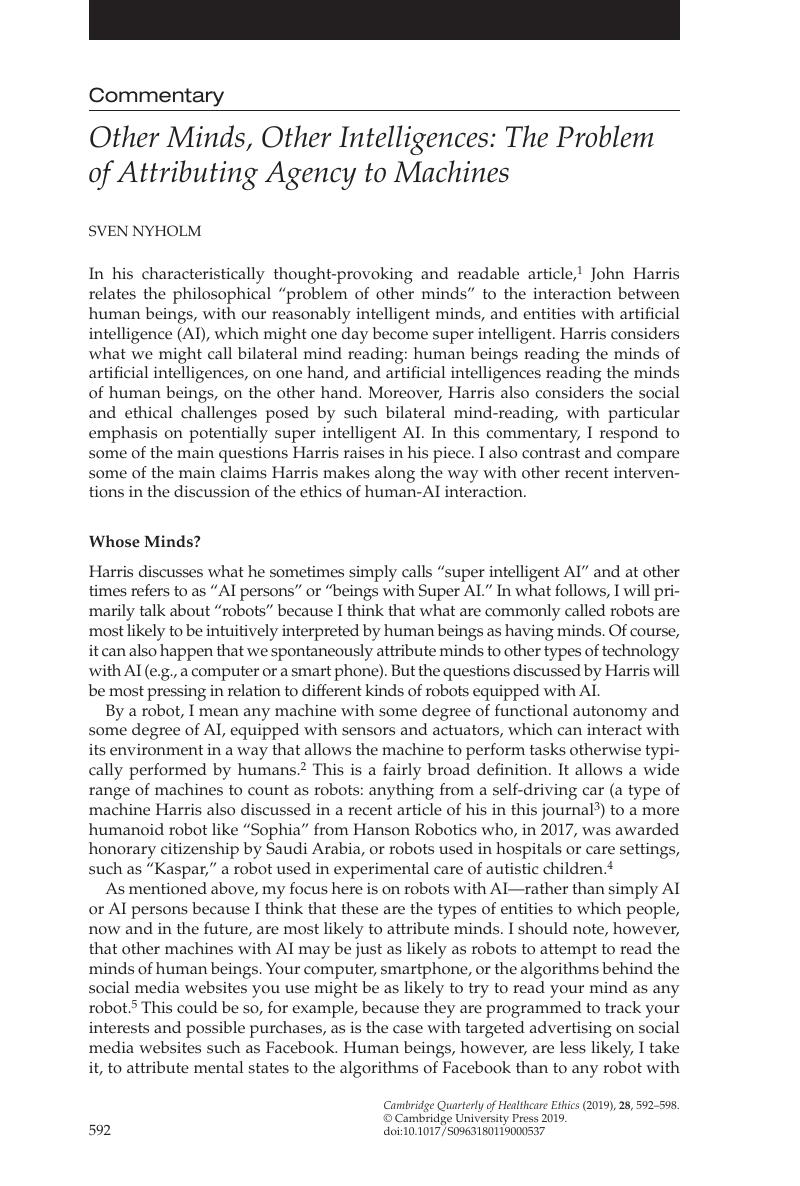Article contents
Other Minds, Other Intelligences: The Problem of Attributing Agency to Machines
Published online by Cambridge University Press: 17 September 2019
Abstract

- Type
- Commentary
- Information
- Cambridge Quarterly of Healthcare Ethics , Volume 28 , Special Issue 4: Clinical Neuroethics , October 2019 , pp. 592 - 598
- Copyright
- Copyright © Cambridge University Press 2019
References
Notes
1. Harris, J. Reading the minds of those who never lived. Enhanced beings: The social and ethical challenges posed by super intelligent AI and reasonably intelligent humans. Cambridge Quarterly of Healthcare Ethics 2019;28(4):585–91.Google Scholar
2. Gunkel D. Robot Rights. Cambridge, MA: MIT Press; 2018.
3. Harris, J. Who owns my autonomous vehicle? Ethics and responsibility in artificial and human intelligence. Cambridge Quarterly of Health Care Ethics 2018;27(4):599–609.CrossRefGoogle ScholarPubMed
4. Robins, B, Dautenhahn, K, Dubowski, J. Does appearance matter in the interaction of children with autism with a humanoid robot? Interaction Studies 2006;7(3):479–52.CrossRefGoogle Scholar
5. Frischmann, B, Selinger, E. Re-Engineering Humanity. Cambridge: Cambridge University Press; 2018.CrossRefGoogle Scholar
6. I mention Roomba here because some people treat Roomba in anthropomorphizing ways, such as giving it names and displaying gratitude to and concern for Roomba. See Scheutz, M. The inherent dangers in unidirectional emotional bonds between humans and social robots. In: Lin, P, Abney, K, & Jenkins, R, eds. Robot Ethics: The Social and Ethical Implications of Robotics. Cambridge, MA: MIT Press; 2012, at 205–21.Google Scholar
7. See note 1, Harris 2019.
8. See, for instance, Dennett, D. From Bacteria to Bach and Back Again. Cambridge MA: Harvard University Press; 2017;Google Scholar and Heyes, C. Cognitive Gadgets . Oxford: Oxford University Press; 2018.CrossRefGoogle Scholar
9. Kwiatkowski, R, Lipson, H. Task-agnostic self-modeling machines. Science Robotics 2019;4(26) eaau9354CrossRefGoogle Scholar
10. Some samples: http://blogs.discovermagazine.com/d-brief/2019/01/30/self-aware-robot-arm-learning/#.XGAAjTF3E2x, https://www.forbes.com/sites/bridaineparnell/2019/01/31/robot-know-thyself-engineers-build-a-robotic-arm-that-can-imagine-its-own-self-image/#4cb306f54ee3 (last accessed 5 April 2019).
11. https://twitter.com/RespRobotics/status/1091317102009634817, and https://techxplore.com/news/2019-01-closer-self-aware-machinesengineers-robot.html (last accessed 5 April 2019).
12. See, for instance, Sharkey, N. Mama Mia It’s Sophia: A show robot or dangerous platform to mislead? Forbes Magazine, November 17, 2018; available at https://www.forbes.com/sites/noelsharkey/2018/11/17/mama-mia-its-sophia-a-show-robot-or-dangerous-platform-to-mislead/#5cc17e007ac9Google Scholar (last accessed 5 April 2019).
13. For an overview of the ethics literature on self-driving cars, see Nyholm, S. The ethics of crashes with self-driving cars: A roadmap, I-II. Philosophy Compass 2018;13(7):e12507–e12506.CrossRefGoogle Scholar
14. For example, Robots, Danaher J., law and the retribution gap. Ethics and Information Technology 2016;18(4):299–309.Google Scholar
15. A 2015 Ted talk in which Google’s Chris Urmson claims that Google cars are able to do this s available at https:// www.ted.com/talks/chris_urmson_how_a_driverless_car_sees_the_road)
16. See note 1, Harris 2019, at 587.
17. See note 1, Harris 2019, at 590. Incidentally, Lily, Frank and I discuss the topic of robot sex and consent in our ‘Robot sex and consent: is consent to sex between a robot and a human conceivable, possible, and desirable?’ Artificial Intelligence and Law 2017;25(3):305–23Google Scholar
18. See, for instance, Nijssen, SRR, Müller, BCN, van Baaren, RB, Paulus, M. Saving the robot or the human? Robots who feel deserve moral care. Social Cognition 2019;37(1):41–52.CrossRefGoogle Scholar
19. Gunkel, D. Robot Rights. Cambridge, MA: MIT Press; 2018.CrossRefGoogle Scholar
20. Bryson, J. Robots should be slaves. In: Wilks, Y, ed. Close Engagements with Artificial Companions: Key Social, Psychological, Ethical and Design Issues . Natural Language Processing, vol. 8, Amsterdam: John Benjamins Publishing Company; 2010, at 63–74.CrossRefGoogle Scholar
21. See note 19, Gunkel, 2018. Also, Coeckelbergh M, Robot rights? Towards a social-relational justification of moral consideration. Ethics and Information Technology 2010;12(3):209–21.Google Scholar
22. Danaher, J. The philosophical case for robot friendships. Journal of Posthuman Studies, in press.Google Scholar See also Danaher’s blog post “Ethical behaviourism in the age of the robot,” available at https://philosophicaldisquisitions.blogspot.com/2017/12/ethical-behaviourism-in-age-of-robot.html (last accessed 5 April 2019).
23. Darling, K, Who’s Johnny? Anthropomorphic framing in human-robot interaction, integration, and policy in Lin, P, Abney, K, Jenkins, R, eds. Robot Ethics 2.0: From Autonomous Cars to Artificial Intelligence. New York: Oxford University Press; 2016, at 173–91.Google Scholar
24. Richardson, K. The asymmetrical ‘relationship’: Parallels between prostitution and the development of sex robots. SIGCAS Computers & Society 2015;45(3):290–3.CrossRefGoogle Scholar
25. See note 19, Gunkel 2018.
26. Many thanks to Tomi Kushner for her feedback and helpful suggestions.
- 3
- Cited by




